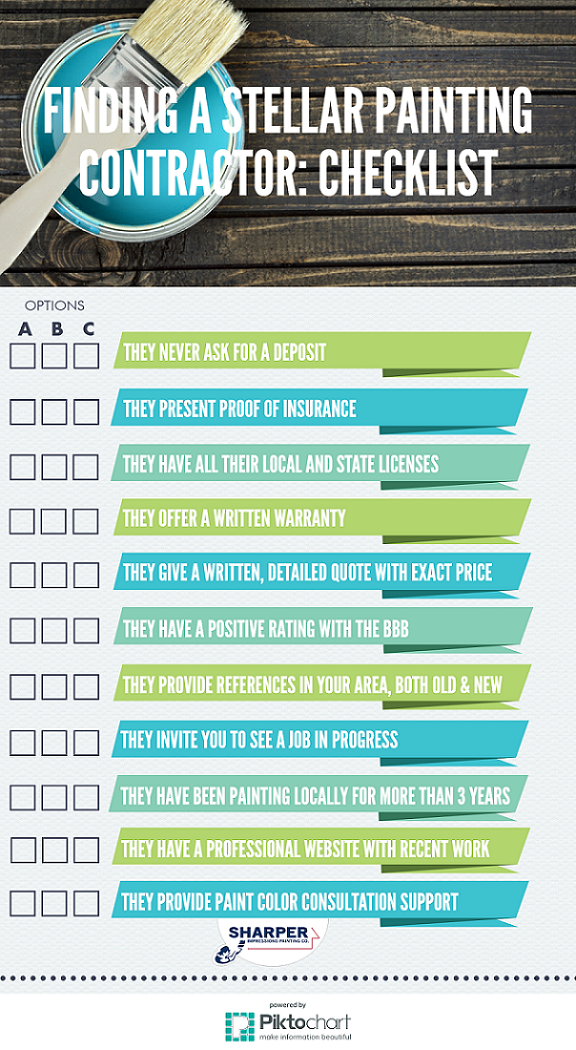Be Prepared To Reveal The Crucial Yet Often Neglected Factor That Has The Ability To Boost Your Indoor Paint Project Significantly
Be Prepared To Reveal The Crucial Yet Often Neglected Factor That Has The Ability To Boost Your Indoor Paint Project Significantly
Blog Article
Web Content Develop By-McDonough Woodard
When it comes to achieving a specialist finish with your indoor paint job, attention to detail is key. From choosing the ideal paint and devices to executing the paint process meticulously, each step plays an essential function in the last end result. Nonetheless, there is one aspect often ignored yet vital for a perfect coating-- the value of correct ventilation throughout the paint procedure. This commonly ignored aspect can considerably affect the overall top quality of your paint task. Interested to understand even more about how ventilation can boost your painting outcomes?
Choosing the Right Paint and Equipment
Wondering which paint and tools are best for your indoor paint job? When it comes to picking the ideal paint, consider elements like the type of surface you're repainting, the desired surface, and the shade alternatives offered. For wall surfaces, a latex paint is frequently the very best selection because of its toughness, very easy clean-up, and quick drying time. If you're repainting a high-traffic area like a corridor or kitchen, a semi-gloss or satin surface might be more suitable as they're much easier to clean.
When it comes to devices, buying premium brushes and rollers can make a considerable distinction in the last end result of your paint work. Look for brushes with thick bristles that appropriate for the sort of paint you're utilizing. Roller covers can be found in various snooze dimensions, with shorter naps being suitable for smooth surface areas like walls and ceilings, while longer naps are better for distinctive surfaces.
Readying Your Room for Paint
To make sure a successful interior paint project, correct preparation of your space is crucial. Beginning by eliminating furniture from the area or moving it to the center and covering it with plastic sheets. Next off, take down any kind of designs, switch over plates, and electrical outlet covers. Usage painter's tape to secure baseboards, trim, and any locations you do not want to repaint. https://interiorhomepaintersnearm98643.blogsidea.com/40381869/accessibility-professional-understandings-on-picking-the-best-shade-scheme-and-strategies-for-a-high-quality-surface-update-your-home-s-design-with-the-assistance-of-experienced-painters and fractures in the wall surfaces with spackling substance, after that sand them smooth once dry. Dust and tidy the wall surfaces to guarantee appropriate paint adhesion.
After preparing the wall surfaces, put down ground cloth to shield your floorings. If you're painting the ceiling, cover the entire floor area with ground cloth, protecting them in place with painter's tape. Make certain proper air flow by opening home windows or utilizing fans to aid with drying out and to reduce the fumes. Finally, collect all your paint materials in one area to have whatever you need within reach. Making https://www.countryliving.com/home-design/decorating-ideas/advice/g1704/kitchen-paint-color-ideas/ to prepare your room will make the paint procedure smoother and help you attain an expert coating.
Implementing the Paint Process
Begin by selecting the proper paint shade and finish for the space you're repainting. Consider the state of mind you wish to produce and just how all-natural light influences the color throughout the day. When you have your paint, collect high-quality brushes, rollers, painter's tape, and ground cloth. Before starting, make certain the wall surfaces are clean and dry.
Beginning by cutting in the edges of the wall surfaces and around trim with a brush. Then, utilize a roller to cover larger locations, working in small areas. Remember to keep a damp edge to prevent visible lap marks. Apply a second layer for a specialist surface, if required.
When painting doors and trim, utilize a smaller brush for precision. Work systematically, using thin, also coats. Get rid of the painter's tape while the paint is still somewhat wet to prevent peeling.
Enable the paint to completely dry totally prior to relocating furniture back into area. Take your time and focus on detail for a remarkable coating that will change the look of your room.
Final thought
Since you have complied with these step-by-step pointers for repainting your inside, you're well on your method to attaining an expert coating.
By picking the right paint and devices, preparing your space appropriately, and carrying out the painting procedure with care, you can change your home right into a wonderfully repainted space.
Bear in mind to take your time and enjoy the process for the best results. Happy paint!
